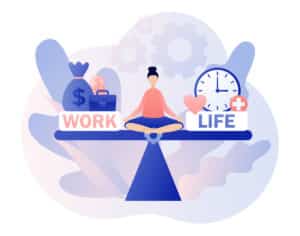We’re in the midst of a phenomenon that has been labeled “The Great Resignation.” People have been leaving their jobs in record numbers – approximately 39 million Americans quit their jobs in the first 10 months of 2021. In addition, an August 2021 jobseeker survey by Bankrate found that approximately 55% of employees in the workforce are planning on searching for a new job in the next year.
While there are undoubtedly a variety of factors causing The Great Resignation, one of the most prominent reasons has been employee burnout. Burnout in the workplace is not a new phenomenon, but the pandemic has exacerbated levels of burnout experienced by many individuals. In fact, a survey conducted by Indeed found that 52% of employees say they feel burnt out.
Fortunately, employers are beginning to take this issue more seriously. Pressure to address this problem has been mounting steadily since the World Health Organization recognized burnout as an occupational phenomenon in 2019. As a business owner, it’s crucial that you take the steps necessary to reduce burnout in your workplace. This will result in a better quality of life for your employees, increase employee retention rates, and improve the productivity and profitability of your business.
 Employee burnout is a type of work-related stress that results in:
Employee burnout is a type of work-related stress that results in:
Common signs of employee burnout include:
When employees experience burnout, their energy becomes focused on daily survival, rather than growing professionally and deriving fulfillment from their work.
As a business owner, it’s in your best interest to take the steps necessary to reduce burnout among your team. Companies that experience high levels of employee burnout have:
In addition, a Gallup study found that employees who experience burnout at work are:
The most common causes of employee burnout all relate to the company culture and the work conditions that have been established. A Gallup survey of 7,500 employees found the top five causes of burnout to be:
 Unfair treatment at work
Unfair treatment at workBased on this list, it’s clear that the primary causes of employee burnout largely lie with the culture, actions and policies established by the company. Therefore, business owners have the ability to take ownership of the problem and reduce burnout by implementing some changes to their company policies. The following steps will help improve your culture and experience a corresponding reduction in the level of burnout your employees experience.
It’s crucial that your employees have a manageable, sustainable workload. While it may be unavoidable for workloads to briefly spike on occasion, it’s unrealistic to expect employees to sustain these heavy workloads for extended periods of time without experiencing greater levels of stress and burning out.
When employee workloads remain balanced and reasonable, your team will have the ability to get their work done on time and at a high level. They will also be able to build time into their schedules for professional growth, personal development, proper rest, and work recovery. This will lead to a more positive mindset that will improve productivity and employee retention.
The following tactics will help you more effectively monitor and balance employee workloads:
When you convey to your employees that you value their health and mental/emotional wellbeing, it can significantly reduce feelings of stress and burnout. To do this, it’s important to prioritize employee wellbeing as part of your company culture. By encouraging employees to live healthier lives, creating policies that promote healthy living, and providing resources to assist employees who struggle in this area, your employees are more likely to feel empowered to take better care of themselves.
Work-Life Balance
 The core component of promoting employee wellbeing is to prioritize work-life balance in your company culture. Working excessively long hours, putting work ahead of family obligations, and working during your personal time are surefire ways to burn out. Employees who cultivate these habits aren’t taking care of themselves, and companies who create a culture where employees feel compelled to develop these habits are setting a tone for burnout.
The core component of promoting employee wellbeing is to prioritize work-life balance in your company culture. Working excessively long hours, putting work ahead of family obligations, and working during your personal time are surefire ways to burn out. Employees who cultivate these habits aren’t taking care of themselves, and companies who create a culture where employees feel compelled to develop these habits are setting a tone for burnout.
Some important policies that can help improve work-life balance include:
Provide Mental Health Days
Morale tends to decline during busy times of the year when workloads increase and the job becomes more stressful. Encouraging employees to take a mental health day during these times – and building these days into your time off benefits – will help reduce this stress and give your team an opportunity to decompress.
Encourage Employees to Use Vacation Days
Many employees fail to use their allotted vacation time for a variety of reasons. Whether they feel like they have too much work to take time off, they feel like they will be judged for using all their vacation time, they don’t have anywhere they want to go for a vacation, or some entirely different reason, the failure to use these important days can detract from work-life balance and lead to burnout.
Vacation time is an important opportunity for employees to refresh, recharge and focus on themselves. This will allow them to return to work in a better mental place and ready to perform at peak levels. Monitor the vacation time being taken by each employee. When someone isn’t taking their time off, reach out to them to let them know they should schedule a vacation.
Discourage Working After Hours
Many individuals often feel that working late hours will make a favorable impression on management, demonstrating that they are dedicated and hard working. However, this practice often leads to burnout. Consider a policy that discourages employees from checking and responding to emails after regular work hours. If you notice individuals putting in time on weekends, remind them that this is their time off to focus on themselves and their family.
Allow Flexible Schedules
Not all employees are most productive at the same times of the day. Similarly, family obligations may create challenges for certain employees to keep rigid hours. Allowing employees to create their own flexible schedule – within reason – can help improve work-life balance.
Working at home for an hour in the morning and coming into the office later may help avoid rush hour traffic, which can significantly improve quality of life. Similarly, allowing an employee to leave early to pick their children up from school and then finish the day at home may provide huge quality of life benefits that will reduce stress and burnout.
Physical Health Improves Emotional Wellbeing
 Individuals who are physically active and live healthy, fit lifestyles tend to experience better emotional health. This will help prevent burnout. Encouraging employees to prioritize exercise and healthy living can significantly reduce the likelihood of burnout. This can be done in several ways:
Individuals who are physically active and live healthy, fit lifestyles tend to experience better emotional health. This will help prevent burnout. Encouraging employees to prioritize exercise and healthy living can significantly reduce the likelihood of burnout. This can be done in several ways:
Most work environments are fast paced, and employees often have to juggle multiple tasks at once. This can become overwhelming for some people if they don’t know how to prioritize their work.
One useful tool for managing and prioritizing work is to follow the 80/20 rule: spend 80% of your time on the 20% of the tasks that are most important to achieving your established goals. This will help prioritize the tasks that are truly essential, ensuring they get done. This will help employees feel more confident in their ability to deliver the important results tasked of them, which will reduce burnout.
When employees have meaningful relationships that go beyond work-related interactions, it creates a more positive work environment and a more tight-knit team. Employees who know each other on a more personal level and genuinely like each other are generally more motivated, support each other more frequently, and are less likely to burn out.
Make sure you build in authentic team-building time as part of your company culture. This can include casual Friday afternoon office happy hours (these can be done over Zoom if you have a remote work environment) or monthly all-company lunches. It should also involve off-site teambuilding activities several times a year. Whether you take your employees bowling, to an escape room, or simply spend a couple hours chatting at a bar, this time will build relationships that will improve your employees’ work experience.
More than ever, employees want to feel a sense of purpose at their job, and they want to feel like what they do is meaningful to them and to society at large. When individuals connect their role to the company’s mission and core values, they will be able to more easily see how they are making a difference with their work. This will help reduce many of the negative emotions which lead to burnout.
For this to be effective, it’s crucial that you hire employees who align with your company values. Make sure that your hiring process addresses how potential candidates fit with your vision, mission and values. This is just as important as identifying the candidates who possess the right skills to do the job.
Often, it can be challenging to identify the ways in which your company culture may be contributing to the employee burnout you’re experiencing. Having the perspective of an independent, third-party employee engagement firm can help you implement the policy changes necessary to improve your company culture and reduce burnout. PassioHR can help guide you through this process.
At PassioHR, we’ve created our exclusive Elevated Engagement Plus™ Approach with your unique needs in mind. Our process involves taking a deep dive into your organization to better understand your business goals and your unique workforce dynamic. Then, we’ll work with you to identify the proper policy changes to create a more inspired and successful organization.
Contact us today to schedule a consultation.
Full PEO Services creating inspired, successful teams and comprehensive employee engagement.
Get Started